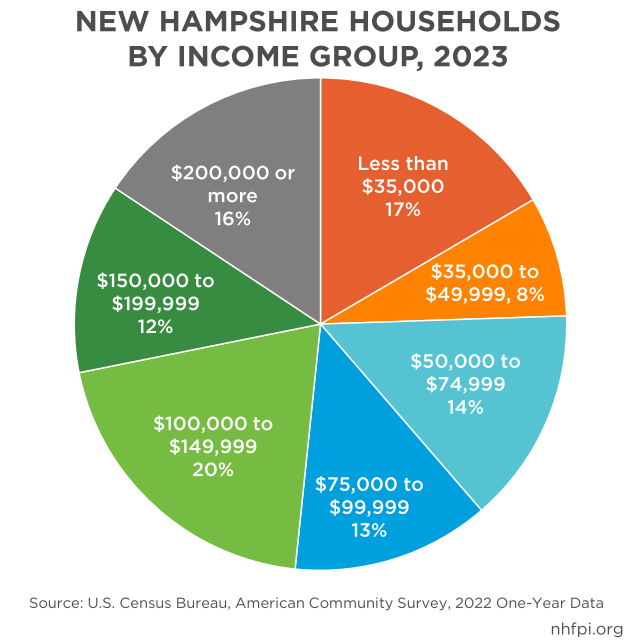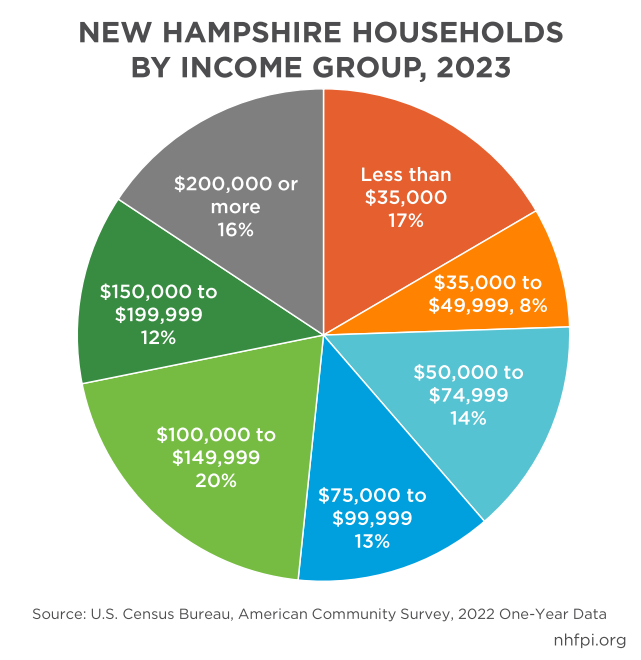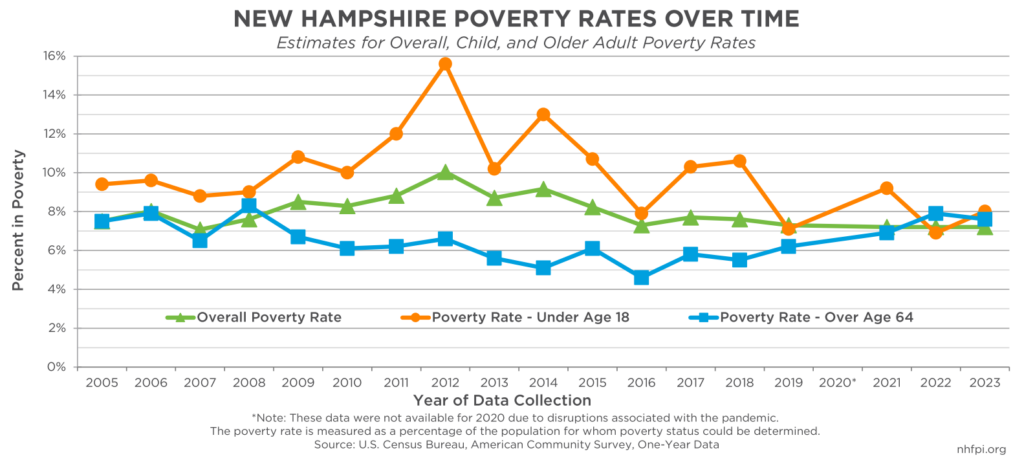New Hampshire
New Hampshire’s Median Household Income Increased in 2023, Poverty Remained Steady

New data released by the U.S. Census Bureau provide key insights into the economic well-being of Granite Staters. The American Community Survey’s 2023 state-level data showed that median household income recovered to 2021 levels after adjusting for inflation, following a decline in 2022. While the median household income increased, the poverty rate held steady at 7.2 percent, reflecting that nearly 100,000 New Hampshire residents had very little income despite purchasing power growing for the median household.
Household Incomes
The estimated median household income in New Hampshire was $96,838, based on data collected by the American Community Survey during 2023. This median income estimate increased from the $89,992 estimated for 2022, even after adjusting for inflation and accounting for statistical uncertainty. After taking inflation into account, the median household income effectively rebounded to about 2021 levels; in 2022, median household income fell behind inflation, and spending power dropped relative to 2021. The 2023 data show this median income recovered to 2021 levels after the inflation adjustment of 2021 dollars to 2023 purchasing power. The inflation-adjusted 2023 household incomes were higher than before the COVID-19 pandemic and prior to the Great Recession of 2007-2009, and reflected the relative speed of the post-pandemic recovery compared to the slow recovery from the Great Recession.
Of the estimated 569,493 households in New Hampshire in 2023, 25 percent, or one in four, had pre-tax incomes below $50,000 annually. About 17 percent had incomes lower than $35,000, and nearly 11 percent had estimated incomes below $25,000 during 2023. About 48 percent had incomes over $100,000, and almost 16 percent had incomes of $200,000 or more.

The average household size in New Hampshire was 2.39 people in the 2023 data. The Massachusetts Institute of Technology estimated the living wage income for a two-person household in New Hampshire in 2024 was $67,155 for two adults, $88,074 for one adult with one child, and $97,876 for two working adults with one child. The Economic Policy Institute estimated the income a family needed in 2024 for a “modest yet adequate standard of living,” which does not include costs such as paying for student loans or for homeownership as well as for any form of entertainment, ranged from $72,501 to $94,597 for a household with two adults and one child, depending on where they lived in New Hampshire.
Poverty in New Hampshire
The U.S. Census Bureau calculates poverty thresholds for different household sizes. The Official Poverty Measure poverty threshold is not adjusted for changes in living costs between the 48 contiguous United States; other measures of hardship differ, such as the regional housing cost variations incorporated into the Supplemental Poverty Measure. The Official Poverty Measure thresholds for 2023 are $15,852 for a single person under 65 years old, $21,002 for a two-person household with one child and one adult under 65, $24,526 for a three-person household with one child, and $30,900 for a four-person household with two children.
An estimated 98,000 people lived with incomes below Official Poverty Measure poverty thresholds in 2023. This estimate is slightly larger than the estimated 2023 populations of Claremont, Concord, Laconia, and Portsmouth combined. That total number of people in poverty included about 20,000 children and 21,000 older adults.
The overall poverty rate in New Hampshire was 7.2 percent, according to the Official Poverty Measure, which was the same estimated rate as 2022 and 2021, and statistically indistinguishable from the 7.3 percent poverty rate from 2019. The poverty rate for children was 8.0 percent, which was statistically indistinguishable from the 2022 rate. Poverty for older adults, at an estimated 7.6 percent, was also substantially unchanged from 2022, but remained higher than it was in 2019.

New Hampshire had the lowest Official Poverty Measure poverty rate among the states, with Utah’s 9.0 percent and both Colorado’s and Minnesota’s 9.3 percent rates as the next closest estimates. However, other measures of hardship, also published by the U.S. Census Bureau in September, complicate that conclusion. Using the Supplemental Poverty Measure, which adjusts for certain expenses, taxes and noncash benefits, household compositions, and geographic differences in housing costs, New Hampshire’s 7.4 percent poverty rate for the 2021-2023 period was higher than Maine’s 5.9 percent; Maine’s rate was statistically tied for the lowest in the country with several other states, including Minnesota and South Dakota. The Supplemental Poverty Measure, while not a replacement of the Official Poverty Measure, can capture key economic conditions impacting household well-being that are missed by the Official Poverty Measure, such as the reduction of child poverty by half in 2021 due largely to the expansion of the Child Tax Credit.
Within the Official Poverty Measure data for New Hampshire, 2023 continued to show longstanding differences in economic hardship between groups, reflecting both historical and present-day barriers to opportunity that hinder upward mobility. While data limitations prevent a reliable, comprehensive analysis of 2023 data, the estimated poverty rate for Granite Staters identifying as of two or more races was higher than for white residents who did not identify as Hispanic or Latino. The poverty rate for New Hampshire residents who identified themselves as Asian was lower than for non-Hispanic white residents. Data to be published in December 2024 will provide more reliable insights into the well-being of groups and geographies within the Granite State.
Other Key Data
Beyond these topline numbers, the American Community Survey provides a wealth of information on the lives and well-being of Granite Staters. For example, about 51 percent of the estimated 149,626 renter households in New Hampshire paid more than 30 percent of their incomes on rent and utilities during 2023. About 13 percent of workers age 16 and over commuted out of state for employment, while about 16 percent worked from home. Income inequality, as measured by the Gini Index, is not higher than it was just before the COVID-19 pandemic, but is higher than it was in 2010. These data, as well as other information recently provided by the U.S. Census Bureau, provide additional insights into the well-being of Granite Staters.
– Phil Sletten, Research Director

New Hampshire
NH Butterfly Monitoring Network Offers Online Trainings

CONTACT:
Heidi Holman, NH Fish and Game: 603-271-2461
Haley Andreozzi, UNH Cooperative Extension: (603) 862-5327
January 10, 2025
Concord, NH — Butterflies serve as important biodiversity indicators for ecosystem health and provide food for many speciess, such as migrating birds. There are more than 100 typess of butterflies in New Hampshire, but data on their presence and distribution is limited. With butterflies using forests, fields, wetlands, and backyards all over the state, volunteer observations are critical to providing a landscape view of these species.
A five-part online training series hosted by the NH Butterfly Monitoring Network will provide information on butterflies in New Hampshire, butterfly biology and identification, and how to get involved with the Network. The NH Butterfly Monitoring Network is a collaborative effort with a goal of engaging volunteers in counting and identifying butterflies across New Hampshire. Data collected by volunteers can contribute to the understanding of long-term trends in butterfly populations and inform conservation actions for both common and declining species.
Webinars in the series will include:
February 12, 6:30–7:30 p.m.: Intro to New Hampshire Butterflies
Mark Ellingwood, Wildlife Biologist and Volunteer with the Harris Center for Conservation Education
February 26, 6:30–7:30 p.m.: Wetland Butterflies of New Hampshire
Rick Van de Poll, Ecologist and Certified Wetland Scientist
March 12, 6:30–7:30 p.m.: Butterflying New Hampshire’s Woodlands
Levi Burford, Coordinator of the Errol Butterfly Count
March 26, 6:30–7:30 p.m.: Identifying New Hampshire’s Grassland Butterflies
Amy Highstrom, Coordinator of the Lake Sunapee Butterfly Count, and Vanessa Johnson, NH Audubon
April 9, 6:30–7:30 p.m.: Become a Volunteer Guide with NH Butterfly Monitoring Network
Haley Andreozzi, UNH Extension
All butterfly enthusiasts are welcome, with or without prior experience. For more information and to register for the session(s) you are interested in, visit nhbutterflies.org.
The NH Butterfly Monitoring Network is led by the NH Fish and Game Department and UNH Cooperative Extension with collaboration from partners statewide, including NH Audubon, Tin Mountain Conservation Center, the Harris Center for Conservation Education, and Ausbon Sargent Land Preservation Trust.
New Hampshire
Cooper scores 20, UAlbany beats New Hampshire

Posted:
Updated:
ALBANY, NY (NEWS10) — A strong second half powered the UAlbany women’s basketball team to their third conference victory in as many contests on Thursday night.
COACH COLLEEN MULLEN: “To start the game, New Hampshire had great defensive intensity and pace. Once we settled in and started moving the ball, we were able to capitalize with our inside-out game. In the second half, we had solid offensive execution and grinded out multiple defensive stops. This was a great team win on both ends.”
KEY STATS
- Graduate student Kayla Cooper led the team with 20 points, six rebounds, three steals, and three assists while shooting over 50% from the field.
- Fellow graduate student Jessica Tomasetti followed with nine points and five rebounds. The point guard also shot 50% from the field.
- Junior Gabriela Falcao tallied a team-high two blocks.
- As a team, the Great Danes totaled nine steals with 19 points off turnovers.
- The UAlbany defense did not allow any singular Wildcat to surpass seven points.
HOW IT HAPPENED
- Graduate student Lilly Phillips scored the first basket of the game after a combined four scoreless possessions.
- That defensive nature continued throughout the rest of the half.
- New Hampshire gained a 9-5 lead within four minutes of action but the Great Danes quickly answered to tie the score in the next two minutes.
- UAlbany ended the quarter with a one-possession advantage, 14-11.
- Throughout the second quarter, the Great Danes allowed just two field goals for five Wildcat points.
- Four different Great Danes scored in a defensive quarter to make it a 24-16 game at halftime.
- The second half was a different game – UAlbany nearly doubled its score from the first half in the third quarter alone.
- The Great Danes began the third with a 12-2 scoring run. Ten of those points were scored in just two minutes and 23 seconds.
- Kayla Cooper and Jessica Tomasetti combined to score 10 additional points and close the third quarter with a 22-point advantage, 46-24.
- Cooper and Tomasetti scored all but three of the 22 points in the third quarter. Cooper tallied 12 alone.
- Following two fourth-quarter layups from senior Laycee Drake and Phillips, the Great Danes held a 26-point lead.
- UAlbany continued to extend their lead throughout the next seven minutes of action. The largest lead of the contest came with 1:24 left – 29 points (59-30).
- The Wildcats got the final say to make it a 27-point decision, 59-32.
NEXT: The Great Danes will close out the week at home against Maine on Saturday (Jan. 11).
New Hampshire
Ayotte uses inaugural speech to praise NH, offer warnings

Gov. Kelly Ayotte used her first speech as New Hampshire’s 83rd chief executive Thursday to call for “common-sense cooperation” as the state tackles issues ranging from housing, to education, to the state budget.
In her roughly 45-minute long inaugural address, Ayotte simultaneously lauded New Hampshire as a model for the rest of the nation, but warned that pressing concerns — financial and otherwise — would require policymakers to make difficult decisions in the coming months.
You can watch Ayotte’s full inauguration speech here.
“I could not be more optimistic about our future, but at the same time we have real challenges that we have to take head on, if we want to keep our state moving in the right direction,” Ayotte told a crowd in the State House’s Representatives Hall that included current lawmakers and state officials, as well as several former governors, congressmen, and other political veterans.
“Whenever we talk about cuts, just like a family making hard decisions, there are things we can’t skimp on: protecting our most vulnerable and serving those most in need.”
Gov. Kelly Ayotte, forecasting upcoming state budget negotiations
Ayotte said she’s proud the state ranks high in categories including freedom, public safety, and taxpayer return on investment, but said slowing tax collections and the end of billions of dollars of federal aid dictates that the state “recalibrate” its spending.
“Whenever we talk about cuts, just like a family making hard decisions, there are things we can’t skimp on: protecting our most vulnerable and serving those most in need,” Ayotte said.
Ayotte’s speech was light on specifics — she called for few clear policy initiatives or spending cuts — but she did announce one new state initiative: a Commission on Government Efficiency, or COGE, to help identify ways to spend less state money. The committee will be led by former Gov. Craig Benson, who nominated Ayotte to be New Hampshire attorney general in 2004, and businessman Andrew Crews, a longtime political donor to Ayotte.
Ayotte told the Democratic leaders of the New Hampshire House and Senate that her door would always be open to them. She meanwhile asked GOP legislative leaders to “marshal our Republican majorities over the next two years to deliver on the promises we made to keep our state moving in the right direction.”
Ayotte called public safety her “absolute top priority” and said she expected Republicans to pass a ban this year on so-called sanctuary policies, which aim to protect undocumented immigrants from criminal penalties. She also said the state needs to further tighten its bail policies, and boost police retirement benefits to make it easier to recruit officers and keep them on the job.
She identified housing as another top issue and said the state needs to “get serious” by modeling good behavior to cities and towns, by enforcing a 60-day turnaround on state permits for new housing projects. She also promised to “strengthen new and existing partnerships” between the state, cities and towns and the private sector to get new housing units built.
Ayotte also highlighted education, and said while New Hampshire’s current rate of pupil spending was “wonderful,” lawmakers need to “keep it up” while simultaneously expanding the state’s voucher-like school choice program. Ayotte also promised to ensure students can learn and teachers can teach without distraction by banning cell phones in the classroom.
“Screens are negatively impacting our learning environments,” Ayotte said. “No more.”
On other issues, Ayotte promised to expand the state’s ranks of mental health providers, strengthen anti-suicide efforts, oppose a controversial landfill proposal in the town of Dalton, and veto any new abortion restrictions.
More digs at Massachusetts — but also a welcome
After framing her gubernatorial campaign last year as a rebuke of Massachusetts, Ayotte also used her inaugural address as another chance to take digs at the Granite State’s southern neighbor.
Ayotte criticized policymakers there for what she described as out-of-control spending, tax hikes, and lax immigration policies. But she did say New Hampshire welcomes Massachusetts residents as shoppers and visitors.
One of Ayotte’s biggest applause lines was addressed to Bay State business leaders.
“To the businesses of Massachusetts: We’d love to have you bring your talents to the Granite State,” she said. “We’re happy to show you why it’s better here.”
Ayotte extended a similar invitation to Canadian businesses, saying they would be especially welcome in New Hampshire’s North Country.
Lawmakers say they’re ready to get to work
Republicans in both legislative chambers will enjoy sizable majorities this session, and the party’s leaders say they’re ready to use those numbers to advance the policy goals Ayotte laid out Thursday.
House Majority Leader Jason Osborne praised the governor’s speech and said that along with the expansion of Education Freedom Accounts, his caucus will focus on “addressing issues of affordability across all sectors: housing, healthcare, electricity, you name it.”
He expressed optimism about Ayotte’s proposed COGE initiative to make government more efficient, but acknowledged that trimming the state budget could cause tension as lawmakers seek to protect their favorite programs.
“Everything we do is someone’s favorite pet project, so we’ve got to figure out who is going to get sent to the chopping block,” he said.
Osborne added that while his majorities are larger this session than last term’s near evenly split House makeup, he knows there will be disagreement within his own caucus.
“The more willing that we are to let people do their own thing, for things that are important to them, the more we’re going to be able to band together and get things done together, as well,” he said.
Sen. James Gray, a Republican from Rochester who leads the Senate Finance Committee, told reporters it was too early in the budgeting process to forecast where the state may trim to balance its books. He said he plans to work with Ayotte to advance her campaign promises.
With a 40-seat disadvantage, House Democrats will have little ability to set the legislative agenda this session, but Minority Leader Alexis Simpson of Exeter said she was grateful that Ayotte expressed a willingness to work across the aisle. She said Democrats would focus on ensuring any budget reductions don’t end up harming the state’s neediest residents.
“We feel these budget cuts at the state level will lead to higher costs at the local level, so we’re really working on making sure the vulnerable populations that Gov. Ayotte spoke about really are protected in this budget,” Simpson said.
Simpson also said she hoped for bipartisan collaboration on housing, mental health services and other issues.
Notable political faces fill the room

Thursday’s inauguration ceremony brought out a crowd of high profile political figures in the state, past and present.
Outgoing Gov. Chris Sununu received a sustained round of applause when he entered Representatives Hall, and was again thanked by Ayotte during her speech for his eight years of service to the state.
Others present included former Congressman Charlie Bass and Scott Brown, a former U.S. Senator representing Massachusetts and ambassador to New Zealand, who was also New Hampshire’s 2014 Republican U.S. Senate nominee. Also in attendance was former Gov. Maggie Hassan, who now serves in the U.S. Senate after unseating Ayotte in 2016.
Former Gov. Craig Benson was seated in the chamber, as was Manchester Mayor Jay Ruais, who entered the room to cheers.
Four of the five justices on the New Hampshire Supreme Court were in attendance, as were federal judges for the District of New Hampshire. New Hampshire Chief Justice Gordon MacDonald swore in Ayotte, while she was flanked by her husband and two children.
Members of the Executive Council were also sworn in during Thursday’s proceedings.
-

 Business1 week ago
Business1 week agoThese are the top 7 issues facing the struggling restaurant industry in 2025
-

 Culture1 week ago
Culture1 week agoThe 25 worst losses in college football history, including Baylor’s 2024 entry at Colorado
-

 Sports1 week ago
Sports1 week agoThe top out-of-contract players available as free transfers: Kimmich, De Bruyne, Van Dijk…
-

 Politics1 week ago
Politics1 week agoNew Orleans attacker had 'remote detonator' for explosives in French Quarter, Biden says
-

 Politics1 week ago
Politics1 week agoCarter's judicial picks reshaped the federal bench across the country
-

 Politics6 days ago
Politics6 days agoWho Are the Recipients of the Presidential Medal of Freedom?
-

 Health5 days ago
Health5 days agoOzempic ‘microdosing’ is the new weight-loss trend: Should you try it?
-

 World1 week ago
World1 week agoIvory Coast says French troops to leave country after decades


















